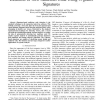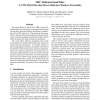58 search results - page 1 / 12 » Detection of New Malicious Code Using N-grams Signatures |
PST
2004
13 years 7 months ago
2004
Signature-based malicious code detection is the standard technique in all commercial anti-virus software. This method can detect a virus only after the virus has appeared and cause...
ISI
2007
Springer
13 years 5 months ago
2007
Springer
—Detecting unknown malicious code (malcode) is a challenging task. Current common solutions, such as anti-virus tools, rely heavily on prior explicit knowledge of specific instan...
USENIX
2001
13 years 7 months ago
2001
We present Malicious Email Filter, MEF, a freely distributed malicious binary filter incorporated into Procmail that can detect malicious Windows attachments by integrating with a...
COMPSAC
2004
IEEE
13 years 9 months ago
2004
IEEE
The current commercial anti-virus software detects a virus only after the virus has appeared and caused damage. Motivated by the standard signature-based technique for detecting v...
WWW
2010
ACM
14 years 20 days ago
2010
ACM
JavaScript is a browser scripting language that allows developers to create sophisticated client-side interfaces for web applications. However, JavaScript code is also used to car...


